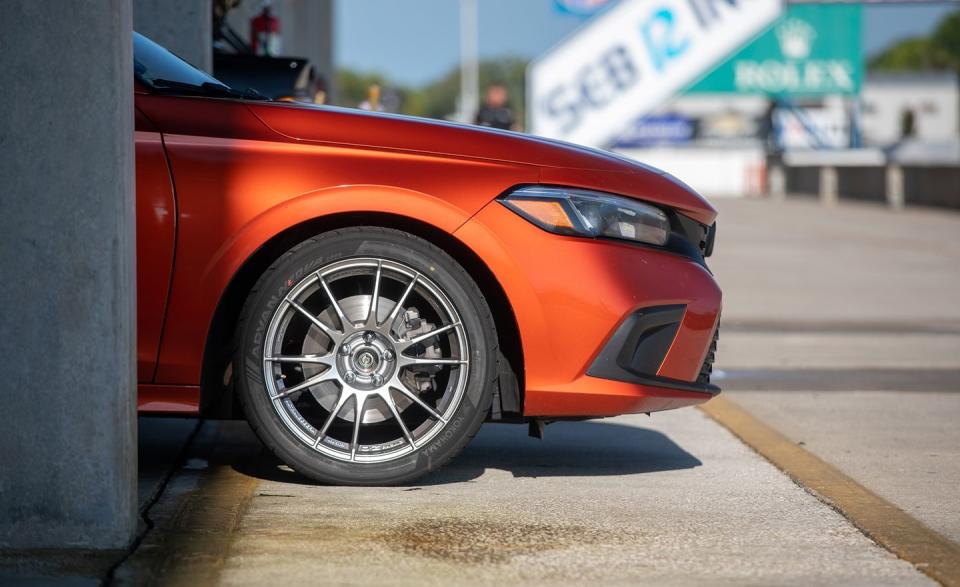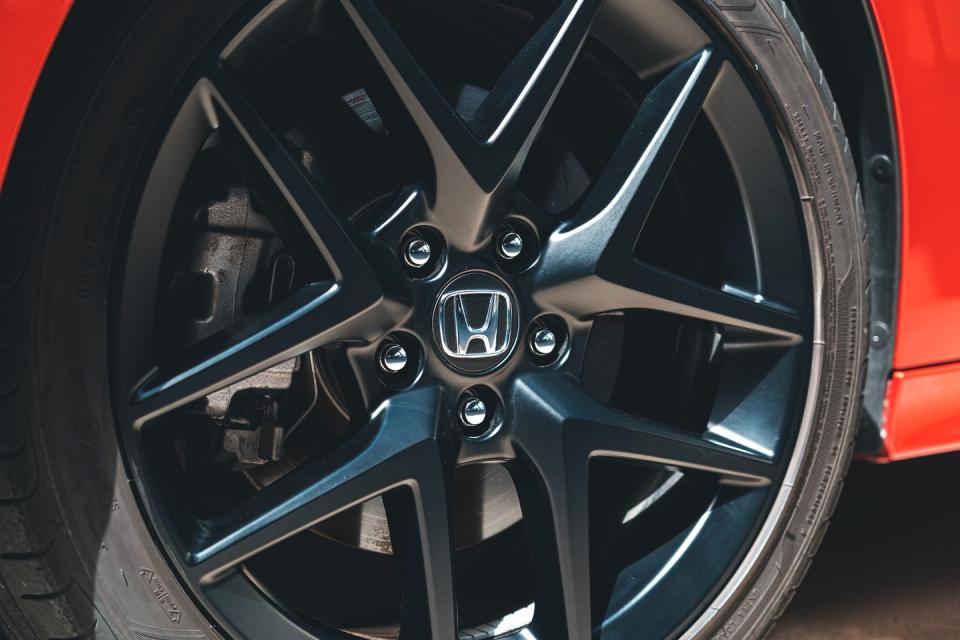Our 2022 Honda Civic Si Tracks Sebring

20,000-Mile Update
Biting at the ankles of a Porsche 911 GT3 through Sebring International Raceway's Gendebien Bend with enough momentum to nearly overtake it made me feel like IMSA's Mario Farnbacher. Unfortunately, I'm no Farnbacher. And instead of his NSX race car, I'm swinging through the gears in Car and Driver's long-term 200-hp Honda Civic Si. To say the nearly 3000-mile round trip from our Michigan office for an instructional weekend with the Florida region of the National Auto Sport Association was worth those few seconds is to state the obvious: Hell yeah they were.
We drove for nearly 20 hours to the Sunshine State, the rear seats stuffed with a fresh set of 18-inch OZ Racing Ultraleggera wheels wrapped in Yokohama's new Advan Neova AD09 track tires. The rest of the tools and luggage fit cleanly in the trunk—no need for a trailer. And with a full track-weekend payload, the Civic Si averaged 31 mpg.
Getting the Finger in Traffic
A far cry from Honda's TCA race car, our long-term Civic Si donned easy-to-install upgrades that come highly recommended for track use. We fit fresh OE rotors, Carbotech XP12 brake pads (which we built ourselves at Carbotech, as detailed in our last update), Castrol React SRF Racing DOT 4 brake fluid, and the lighter OZ 18-inch wheels that we sourced from Tire Rack.

For this exercise, NASA's Florida region kindly hosted us to experience the High Performance Driver Education (HPDE) program offered at tracks across the U.S. There are four levels of HPDE, and as someone who's done more Gran Turismo than Green Hell, I started in HPDE1 with the rest of the noobs.
Passing is restricted to straightaways, and it's up to the slower car to decide where and when the faster drivers will overtake. This is called a point-by. It's an additional safety net to keep cars from trading paint. When new drivers try to articulate simple communication, hilarity often ensues as they point cars toward the grass or an impassable wall. On one occasion, the driver ahead of us pointed directly up into the air. Lacking the 55 inches of ground clearance needed to make a clean pass over that car, we waited for the next straight.
Our plea for more horsepower during our first drive in the Si escalated to flat-out begging during Sebring's speedy sections, including the front straight, Flying Fortress Straight, and especially on the Ulmann Straight. While the Si doesn't have the angry ring of high-revving VTEC Civics of the past, its humble exhaust note is just barely loud enough to notify you when you're reaching the 6600-rpm redline.
There's no wrestling with torque steer when exiting corners at full blast, and the car's helical limited-slip differential in combination with Yokohama's track rubber delivered exceptional grip. We discovered that nothing scrapes or explodes when you bounce through the curbing in Turns 4 and 5; the sporty suspension settles nicely without upsetting the car.

Jerry Speaks, We Listen
Our instructor, Jerry Mathias, spoke into the microphone with the rapidness of a NASCAR spotter. "Turn in here. Ya left about six feet between you and the apex on that one. Don't worry about this clown; we don't know what he's gonna do here. Remember, just drive your line." Jerry flew MH-47G Chinook helicopters for the U.S. Army's 160th Special Operations Aviation Regiment, and he previously was an instructor pilot in the AH-6 Little Bird gunship and flew UH-60 Black Hawk helicopters in the Gulf War. He's the perfect instructor for us, taking things as serious as we'd hope and offering extra instruction via cocktail napkin and YouTube videos in the hotel bar the night before.
"The Beast," as his 2019 Dodge Challenger Redeye is known around the paddock, feels like a HIIT (high-intensity interval training) neck exercise from the passenger's seat. While Mathias's Hellcat approached 150 mph on the Ulmann Straight, our Civic did 111 mph—provided we got the exit of the preceding Le Mans corner mostly right.
Our group included more than 25 cars, including Corvettes, Mustangs, Bimmers, and a batch of recently purchased Toyota Supras and GR86s cashing in on the included NASA membership and complimentary track day. With Mathias's help, toward the end the day, instead of only giving point-bys, we caught up to some BMW 330is and C8 Corvettes in higher HPDE classes, forcing them to point us by.
Out of Quarters
NASA maintains that HPDE is strictly for educational purposes, but it takes a lot to subdue the instinct to drive competitively on the track. At some point during a Sunday-morning session, I was fine-tuning clean and smooth arcs around Collier Curve. Less than 24 hours earlier, I couldn't have told you where the bathrooms were.

After a gnarly thunderstorm came and went, Mathias and I were the only two who stuck around for the final session. It was a wet one. The apexes we had so intensely practiced clipping earlier had flooded into inland lakes. Our Blazing Orange Pearl Civic Si splashed its way to the end of an exciting weekend. As we crossed the final checkered flag, Mathias's voice came through the headset as smoothly as a prerecorded ATC message: "Out of quarters."
What's the Damage?
After the first few hot laps in each session, the car would show a brake-system warning light until we cycled the ignition before the next outing. The owner's manual says this is designed to warn drivers of a brake-system malfunction. We're not sure why the message kept popping up; with our upgraded brakes and higher-temp fluid, the brake pedal remained firm on the track and all the way back home.

We were quick to reinstall the original brake rotors and pads once we returned to our HQ in Michigan. Despite serious track time between two large swaths of highway driving, the Civic Si required no additional oil or coolant. We did notice that the dust boots around the front calipers appeared to have undergone some light blowtorching, but not enough to warrant replacement.
To date, the only significant damage to the Civic Si occurred off-track. The windshield, slapped by a stone, cracked and had to be replaced. The universally popular excuse more commonly known as "supply issues" had us looking through the rather distracting glass crosshairs for more than two weeks before an aftermarket windshield finally arrived at the local body shop. Replacement and calibration cost $759. That was followed by a routine oil change at 22,934 miles, costing $149.
The Civic Si has progressed through two SCCA autocross events plus its most recent track day at Sebring, and we plan to continue to track it through the rest of the year. After all, we still have plenty of brake pad left to burn through.
Months in Fleet: 8 months Current Mileage: 24,176 miles
Average Fuel Economy: 31 mpg
Fuel Tank Size: 12.4 gal Observed Fuel Range: 380 miles
Service: $218 Normal Wear: $0 Repair: $0 Damage and Destruction: $759
10,000-Mile Update
The new-car smell has been replaced with fast-food aromatherapy from over 13,000 miles of road trips and commutes, but the staff continues to admire our long-term Honda Civic Si enough to want more from it. While it continues to gobble up miles without any major misadventure, lurgy, or katzenjammer (put down the thesaurus before someone gets knackered), there are a few areas we feel the 11th-gen Civic could use some extra ketchup.
We've been scouring the web for aftermarket hardware that will take the Civic Si to the next level. During our new braking test from 100 mph its brakes went full quasar. High temperatures triggered a brake-system warning light, and we experienced significant brake fade. Although not a likely scenario in normal driving conditions—unless you normally drive 100 mph—it was an obvious area for improvement before attending upcoming track days.

Until recently, no one provided upgraded brake pads for the brand-new 2022 Si. Although it shares the same calipers and pads as the current Accord, track-grade hardware in the family-sedan segment is about as common as baby formula right now at a Piggly Wiggly. So, we're addressing the situation the way most Honda Civic owners fix things, DIY-style.
Brake Last, Finish First
We called Mike Puskar, owner of Carbotech Performance Brakes, for help. He assured us his track pads would upgrade the Si's brake performance from stepping in something stinky to stepping on something strong. Mike invited us to Carbotech's production facility in Concord, North Carolina, to build our own set.

Since 1996, Carbotech has helped race cars brake later with its high-temp ceramic Kevlar friction material. Most pads sold today are either semi-metallic or ceramic compounds, and they aren't built for track use. Carbotech's pads range in capability from 800 degrees Fahrenheit in the everyday street compound all the way to race pads good for up to 2000 degrees. Each pad is hand-built by one of Carbotech's seasoned brake-ologists.

 Yahoo Autos
Yahoo Autos 